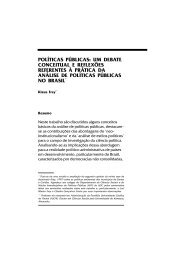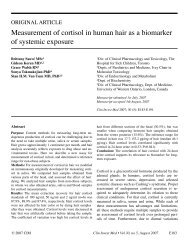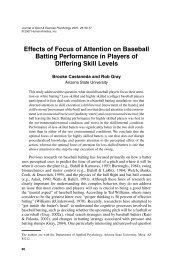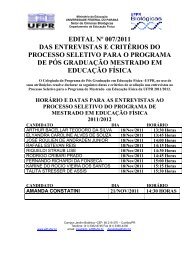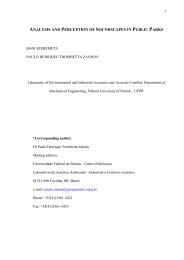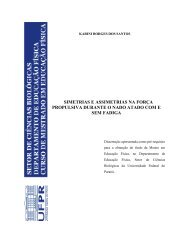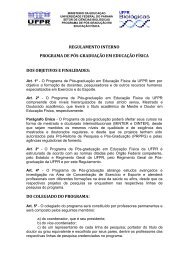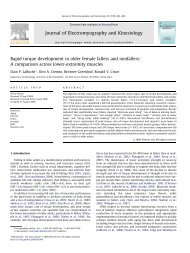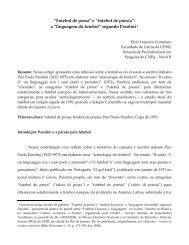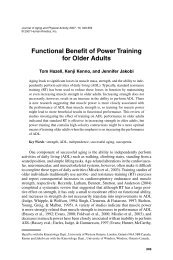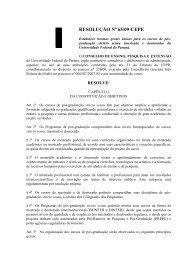Lactate threshold concepts - UFPR
Lactate threshold concepts - UFPR
Lactate threshold concepts - UFPR
Create successful ePaper yourself
Turn your PDF publications into a flip-book with our unique Google optimized e-Paper software.
474 Faude et al.<br />
rectus femoris that were coincidental with the<br />
aerobic-anaerobic transition in 28 elite male<br />
cyclists.<br />
The widespread use of this model as well as<br />
the absence of an accepted alternative was the<br />
rationale for using this framework in the present<br />
review to categorize published LT <strong>concepts</strong>.<br />
3. Validation of <strong>Lactate</strong> Thresholds<br />
3.1 Competition Performance<br />
It is widely accepted that LTs (and the submaximal<br />
course of bLa during incremental<br />
exercise) are a criterion measure for aerobic<br />
endurance performance. [24,26,30,72,81,108] In particular,<br />
it has been shown that LTs are superior to<br />
maximal oxygen uptake when assessing endurance<br />
performance in homogenous groups of<br />
athletes. [11,12,109-111] The obvious gold standard<br />
to validate an LT concept is to compare it with<br />
the most recent competition performance in an<br />
endurance event (concurrent validity) or to assess<br />
its value in predicting endurance performance in<br />
future events (predictive validity). As an alternative<br />
to competition performance, the results of<br />
laboratory tests simulating an endurance event<br />
can be used. This might have the advantage of<br />
a higher standardization and, therefore, these<br />
test results may be more reliable. Correlations<br />
between the test value (LT) and the validity<br />
criterion (competition performance) can be dependent<br />
on several confounding factors such<br />
as, for example, the chosen competitive event<br />
(duration, laboratory or outdoor, athletic track<br />
or off-road), the sport that is evaluated as well<br />
as sex or age group and its heterogeneity in terms<br />
of endurance.<br />
3.2 The Maximal <strong>Lactate</strong> Steady State<br />
Endurance capacity can – from a metabolic<br />
point of view – be regarded as the highest steady<br />
state by energy supply from oxidative phosphorylation.<br />
[87] Therefore, another approach to assess<br />
aerobic endurance performance is the determination<br />
of the highest constant exercise intensity<br />
that can be maintained for a longer period of time<br />
Blood lactate concentration (mmol/L)<br />
10<br />
8<br />
6<br />
4<br />
2<br />
0<br />
Rest<br />
10 20 30 40<br />
Time (min)<br />
MLSS<br />
Fig. 2. The blood lactate response to several constant workload<br />
exercises with different intensities. The highest workload during<br />
which blood lactate concentrations can be still accepted as being<br />
steady state is defined as the maximal lactate steady state (MLSS).<br />
without a continuous rise in bLa. This intensity<br />
represents the MLSS, which has been shown to be<br />
highly related to competition performance in<br />
endurance events (r [correlation coefficient] =<br />
0.92 with 8 km running, r = 0.87 with 5 km running<br />
and r = 0.84 with 40 km cycling time trial<br />
speed, respectively). [112-114] The MLSS has been<br />
defined by some authors as the ‘anaerobic<br />
<strong>threshold</strong>’ because it represents an exercise<br />
intensity that can be maintained without considerable<br />
contribution of anaerobic metabolism.<br />
[27,30,50,72,115] Each higher intensity results in<br />
a clearly identifiable increase in bLa with time<br />
during constant load work. [50,86,88]<br />
The gold standard for the determination of the<br />
MLSS is performing several constant load trials<br />
of at least 30 minutes’ duration on different days<br />
at various exercise intensities (in the range of<br />
50–90% V O 2max , figure 2). [49,50,86,116,117] An increase<br />
in bLa of not more than 1 mmol/L between<br />
10 and 30 minutes during the constant load trials<br />
appears to be the most reasonable procedure for<br />
MLSS determination. [86,115]<br />
MLSS represents a steady state in several but<br />
not all physiological parameters. For instance,<br />
oxygen uptake, carbon dioxide output, respiratory<br />
exchange ratio and bicarbonate concentration<br />
were reported to remain nearly constant<br />
during constant load exercise at MLSS, but<br />
respiratory rate and heart rate significantly<br />
increased during this time. [85,118]<br />
ª 2009 Adis Data Information BV. All rights reserved. Sports Med 2009; 39 (6)



